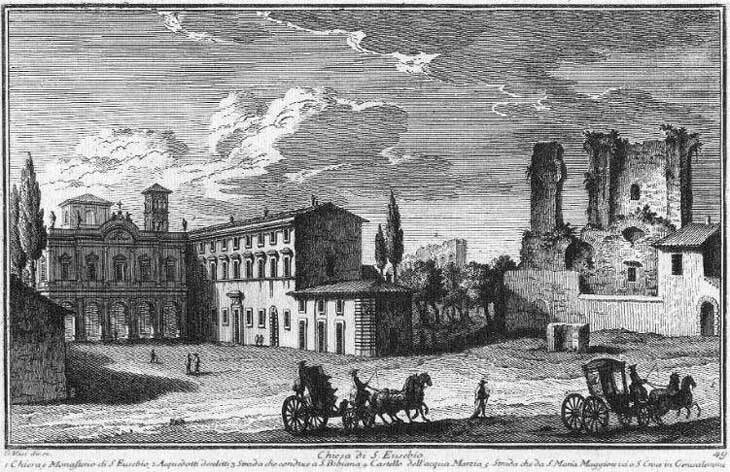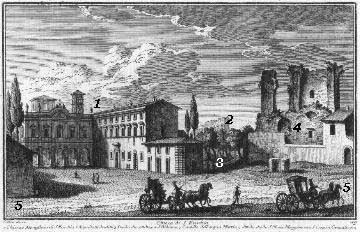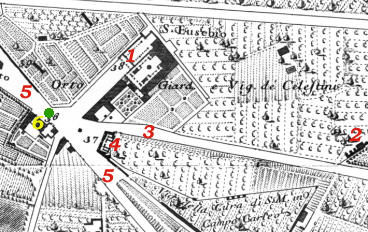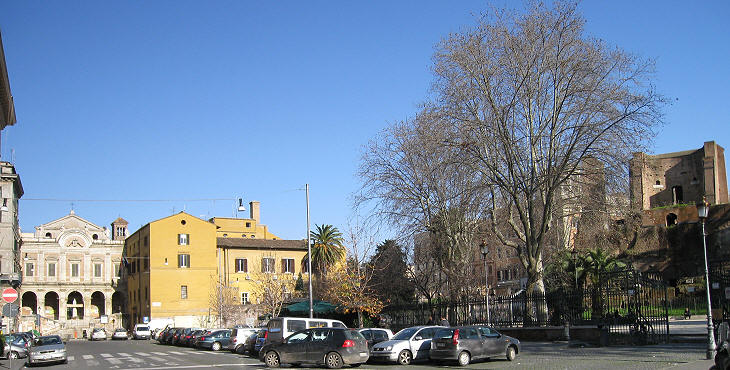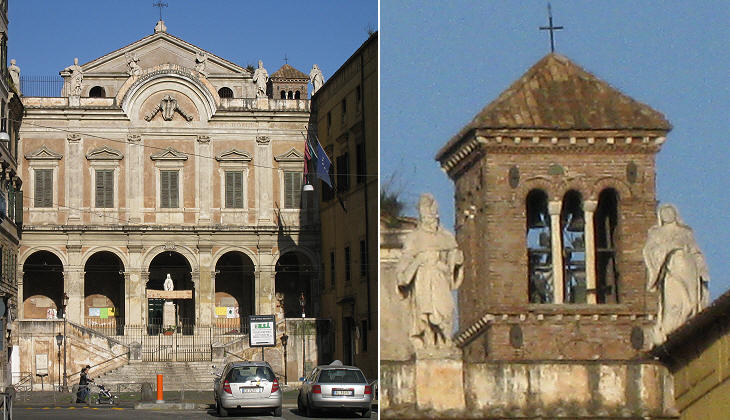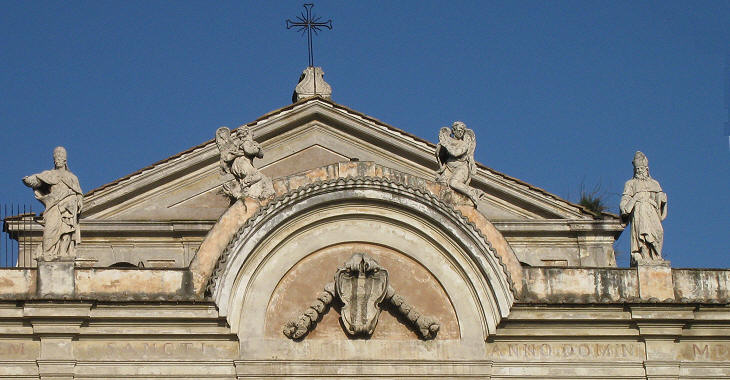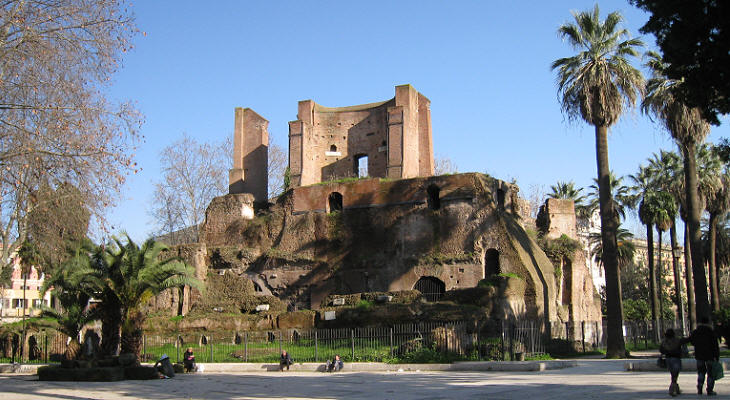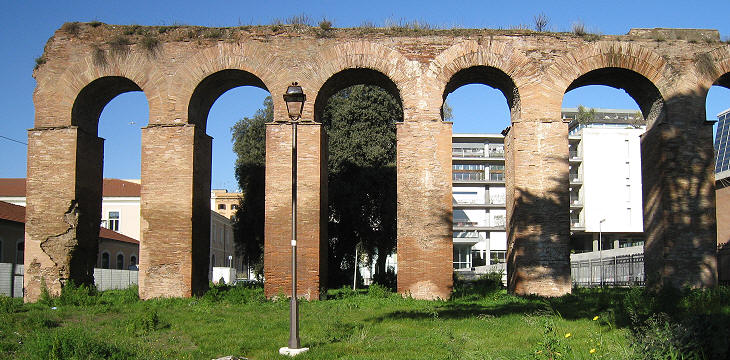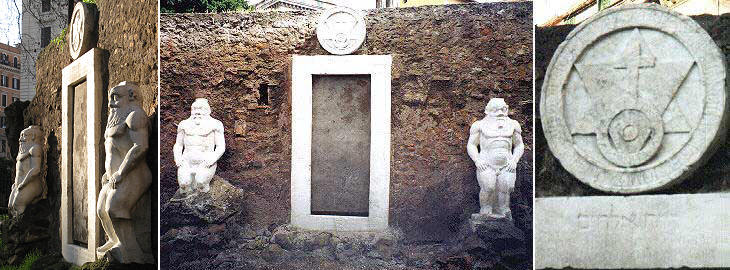  What's New! Detailed Sitemap All images © by Roberto Piperno, owner of the domain. Write to romapip@quipo.it. Text edited by Rosamie Moore. Page revised in October 2009. | S. Eusebio (Book 3) (Map A3) (Day 2) (View B8) (Rione Monti) In this page: The plate by Giuseppe Vasi Today's view S. Eusebio Trofei di Mario (Ninfeo dell'Acqua Giulia) Aqua Iulia Porta Magica di Villa Palombara The Plate (No. 49)
Vasi entitled his books of etchings "The Wonders of Ancient and Modern Rome"; this view which shows an XVIIIth century church next to an imposing ancient building, could have been used as a cover for the books. The view is taken from the green dot in the map below. In the description below the plate Vasi made reference to: 1) Chiesa e Monasterio di S. Eusebio; 2) Derelict aqueducts; 3) Street leading to S. Bibiana; 4) Castello dell'Acqua Marcia; 5) Street leading from S. Maria Maggiore to S. Croce in Gerusalemme. The small 1748 map shows also 6) Chiesa di S. Giuliano. From this map one can see that at Vasi's time S. Eusebio was at the edge of the populated part of Rome.
Today
After the 1870 annexation of Rome to the Kingdom of Italy the area around S. Eusebio was chosen for a new large development in stile torinese i.e. a chequered net of streets flanked by large buildings with porticoes and shops. The main square of the new neighbourhood was dedicated to King Victor Emmanuel II; its gardens include the ancient ruins. In recent years the square has become the heart of Multi-ethnic Rome. The church of S. Giuliano ai Monti which was located opposite S. Eusebio was pulled down in 1874 in the frame of the general reorganization of the area. S. Eusebio
In 313 Emperor Constantine issued an Edict of Tolerance which put an end to the persecution of Christians, but not to the list of martyrs. Eusebius was a priest who preached full adherence to the Nicene Creed and for this he was sentenced to starve to death in his home by Emperor Constantius II, a supporter of the Arian heresy. The very ancient church was entirely rebuilt in the XIIIth century and in 1711 this second church (with the exception of the bell tower) was replaced by a new building designed by Carlo Stefano Fontana, a nephew of Carlo Fontana (you may wish to see the building as it appeared in a 1588 Guide to Rome).
The coat of arms is greatly damaged and it is difficult to see the mountains and the star of Pope Clement XI. The interior of the church contains a ceiling by Raphael Mengs, a German painter who was highly regarded by Johann Joachim Winckelmann, one of the fathers of Neoclassicism. On January 17 the traditional blessing of the animals takes place in the square in front of the church. Trofei di Mario
The imposing Roman ruins were part of a fountain built at the time of Emperor Alexander Severus inside an imperial villa. It had a large central niche (probably housing a statue) flanked by two smaller ones which were decorated with the marble panoplies known as "Trophies of Marius" (actually dating back to the time of Emperor Domitian). In the late XVIth century the panoplies were moved to the balustrade of Piazza del Campidoglio. This fountain is said to have inspired baroque artists in designing the monumental fountains which celebrated new or restored aqueducts (Mostra dell'Acqua Felice, Mostra dell'Acqua Paola and Mostra dell'Acqua Vergine - Fontana di Trevi). Aqua Iulia
Aqua Iulia was an aqueduct built by Marcus Vipsanius Agrippa, son-in-law of Emperor Augustus, in 33 BC. It started near Frascati and it reached Rome at Porta Tiburtina where it joined other aqueducts. In the IIIrd century a short branch was built to supply water to the imperial villa.
The redesign of the area at the end of the XIXth century led to the loss of many villas including Villa Montalto, Villa Altieri and Villa Palombara. Massimiliano II, Marquis of Palombara (1614-85) was interested in alchemy and it is said that he received the formula of the philosopher's stone from a mysterious visitor. After several unsuccessful attempts to decipher it, he decided to share it by putting it, with many other alchemist symbols and puzzling sentences on a side door of his villa. The door was relocated to the gardens of Piazza Vittorio Emanuele II; the sentence containing the magic formula is: MORTUUS VIVIT REX AB IGNE REDIT ET CONIUGIO GAUDET OCCULTO Excerpts from Giuseppe Vasi 1761 Itinerary related to this page:
Next plate in Book 3: Ruine del Tempio di Ercole Callaico Next step in Day 2 itinerary: Chiesa di S. Bibbiana Next step in your tour of Rione Monti: Chiesa di S. Bibbiana |
